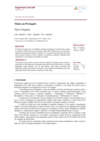Propriedades de concreto auto-adensável contendo cinzas volantes
DOI:
https://doi.org/10.21814/ecum.4189Resumo
Self-compacting concrete is a high performance concrete with excellent rheological properties that can be spread in areas of difficult access. Selfcompacting concrete requires a high consumption of cement production, which has a negative effect on the environmental aspect, since the production of cement releases significant amounts of CO2. This study aims analysis the influence of the substitution (20 and 40% by weight) of Portland cement by fly ash on the selfcompacting concrete properties in the fresh state (spreading, workability, passing ability - J-ring test, viscosity - V-funnel test) and hardened (compressive strength).
The passing ability was proved more effective to the mixture with 20% of replacement. To the viscosity, control concrete had lower flow time in V-funnel. The compressive strength results at 28 days showed a reduction of 9.5% for concrete with 20% fly ash and 77.0% for concrete with 40% fly ash compared to the control concrete.
Referências
ABNT, Brazilian Association for Technical Standards, NBR 5752. Pozzolans - Determination of pozzolanic activity with Portland cement - Test method, Rio de Janeiro, Brazil, 2012.
ABNT, Brazilian Association for Technical Standards, NBR 8953: Concrete for structural use - Density, strength and consistence classification. Rio de Janeiro, 2015a.
ABNT, Brazilian Association for Technical Standards. NBR 12653: Pozzolans - Requirements, Rio de Janeiro, Brazil, 2014.
ABNT, Brazilian Association for Technical Standards. NBR 12655: Portland cement concrete - Preparation, control, receipt and acceptance - Procedure. Rio de Janeiro, 2015b.
ABNT, Brazilian Association for Technical Standards. NBR 15823-1: Self-consolidating concrete Part 1: Classification, control and receipt in the fresh state. Rio de Janeiro, 2010a.
ABNT, Brazilian Association for Technical Standards. NBR 15823-2: Self-consolidating concrete Part 2: Slump-flow test, flow time and visual stability index - Abrams cone method. Rio de Janeiro, 2010b.
ABNT, Brazilian Association for Technical Standards. NBR 15823-3: Self-consolidating concrete Part 3: Determination of the passing ability - J-ring method. Rio de Janeiro, 2010c.
ABNT, Brazilian Association for Technical Standards. NBR 15823-5: Self-consolidating concrete Part 5: Determination of the viscosity - V-funnel test. Rio de Janeiro, 2010d.
ABNT, Brazilian Association for Technical Standards. NBR 5738: Concrete - Procedure for molding and curing concrete test specimens. Rio de Janeiro, 2016.
ABNT, Brazilian Association for Technical Standards. NBR 5739: Concrete - Compression test of cylindrical specimens. Rio de Janeiro, 2007.
Ashtiani M. S.; Scott, A.N., Dhakal R.P. Mechanical and fresh properties of high-strength selfcompacting concrete containing class C fly ash. Construction and Building Materials, v.47, p. 1217-1224, 2013. doi: 10.1016/j.conbuildmat.2013.06.015.
Barbhuiya, S. Effects of fly ash and dolomite powder on the properties of self- compacting concrete. Construction and Building Materials, v. 25, p. 3301-3305, 2011. doi: 10.1016/j.conbuildmat.2011.03.018.
Das, D.; Chatterjee, A. A comparison of hardened properties of fly- ash-based self- compacting concrete and normally compacted concrete under different curing conditions. Magazine of Concrete Research, v. 64(2), p. 129-141, 2012. doi: 10.1680/macr.10.00118.
Dehwah, H.A.F. Mechanical properties of self- compacting concrete incorporating quarry dust powder, silica fume or fly ash. Construction and Building Materials, v. 26(1), p. 547-551, 2011.. doi: 10.1016/j.conbuildmat.2011.06.056.
Department of Thermal Generation – Central of Utilities and Environment - Jorge Lacerda Thermoelectric Complex - Semester Monitoring of Atmospheric Emissions - Summary Report. Capivari de Baixo, Brazil. 2019.
Dinakar, P. Design of self- compacting concrete with fly ash. Magazine of Concrete Research, v. 64(5), p. 401-401, 2012. doi: 10.1680/macr.10.00167.
Effting, C. Mechanics of Fracture Applied to Ductile and Fragile Materials. Masters dissertation. Postgraduate Program in Materials Science and Engineering. State University of State of Santa Catarina, Joinville, Brazil, 2004.
Faseyemi, V. Investigation into the use of microsilica and fly ash in self compacting concrete. International Journal of Research and Reviews in Applied Sciences, v. 24, p. 67-67, 2015.
Gobbo, L.A.. Application of X-ray diffraction and Rietveld method in Portland cement study. Thesis (PhD in Mineral Resources and Hydrogeology), University of São Paulo, São Paulo, Brazil, 2009.
Kreuz, A. L.; Cheriaf, M., Rocha, J. C. Study of concrete properties using heavy ash as part of sand. IX National Meeting of Built Environment Technology. Foz do Iguaçu, Paraná, Brazil, 2002.
Kurtis, K. Portland Cement Hidration. School of civil engineering. Georgia Institute of Tecnology. Atlanta, Georgia. 2012.
Metha, K.P., Monteiro, P.J.M. Concrete: Microstructure, Properties and Materials. Third Edition. McGraw-Hill Education, Nova York, NY, 2014.
Pathak, N.; Siddique, R. Properties of self- compacting-concrete containing fly ash subjected to elevated temperatures. Construction and Building Materials, v. 30, p. 274-280, 2012. doi: 10.1016/j.conbuildmat.2011.11.010.
Polytechnic School of USP. Cement - production worldwide. Available at: http://www.poli.usp.br. Accessed December, 2015.
Ponikiewski, T.; Gołaszewski, J. The influence of high-calcium fly ash on the properties of fresh and hardened self- compacting concrete and high performance self- compacting concrete. Journal of Cleaner Production, v. 71, p. 212-221, 2014. doi: 10.1016/j.jclepro.2014.02.058.
Rohde, G. M., Machado, C. S. (2016). Quantification of fossil coal ash produced in Brazil. Technical Bulletin 36, Porto Alegre, Brazil: Cientec., 2016.
Siddique, R.; Aggarwal, P.; Aggarwal, Y. Influence of water/powder ratio on strength properties of selfcompacting concrete containing coal fly ash and bottom ash. Construction and Building Materials, v. 29, p. 73-81, 2012. doi: 10.1016/j.conbuildmat.2011.10.035.
Votoran cements. Cements, types and compositions. Available at: www.votoran.com.br. Accessed April, 2015.
Zhao, H.; Sun, W.; Wu, X.; Gao, B. The properties of the self- compacting concrete with fly ash and ground granulated blast furnace slag mineral admixtures. Journal of Cleaner Production, v 95, p. 66-74, 2015. doi: 10.1016/j.jclepro.2015.02.050.
Downloads
Publicado
Como Citar
Edição
Secção
Licença
Direitos de Autor (c) 2022 A. Schackow, C. Effting, D. Marcon Neto, D.E. Bonifácio, I.R. Gomes

Este trabalho encontra-se publicado com a Licença Internacional Creative Commons Atribuição 4.0.








